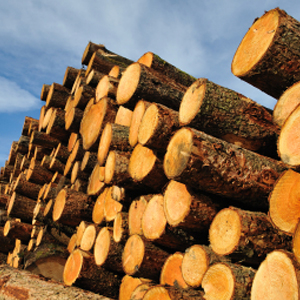
iStock
Using wood for energy is considered cleaner than fossil fuels, but a Dartmouth College-led study finds that logging may release large amounts of carbon stored in deep forest soils. The results appear in the journal Global Change Biology-Bioenergy.
Global atmospheric studies often don't consider carbon in deep (or mineral) soil because it is thought to be stable and unaffected by timber harvesting. But the Dartmouth findings show deep soil can play an important role in carbon emissions in clear-cutting and other intensive forest management practices. The findings suggest that calls for an increased reliance on forest biomass be re-evaluated and that forest carbon analyses are incomplete unless they include deep soil, which stores more than 50% of the carbon in forest soils.
"Our paper suggests the carbon in the mineral soil may change more rapidly, and result in increases in atmospheric carbon dioxide, as a result of disturbances such as logging," said Dartmouth Professor Andrew Friedland, a co-author.
Unintended effect
"Our paper suggests that increased reliance on wood may have the unintended effect of increasing the transfer of carbon from the mineral soil to the atmosphere. So the intended goal of reducing carbon in the atmosphere may not be met."
The federal government is looking to wood, wind, solar, hydropower and other renewable energy sources to address concerns about climate change and energy security. Woody biomass, which includes trees grown on plantations, managed natural forests and logging waste, makes up about 75% of global biofuel production. Mineral soil carbon responses can vary highly depending on harvesting intensity, surface disturbance and soil type.
"Analysis of forest carbon cycles is central to understanding and mitigating climate change, and understanding forest carbon cycles requires an in-depth analysis of the storage in and fluxes among different forest carbon pools, which include aboveground live and dead biomass, as well as the belowground organic soil horizon, mineral soil horizon and roots," Friedland said.
Co-authors included Dartmouth's Thomas Buchholz, a former post-doctoral student, and Claire Hornig, a recent undergraduate student, and researchers from the University of Vermont, Lund University in Sweden and the Vermont Department of Forest, Parks and Recreation. The research was supported by awards to Friedland from the Northeastern States Research Cooperative and the Porter Fund.
Friedland's research focuses on understanding the effects of atmospheric deposition of pollutants and biomass harvesting on elemental cycling processes in high-elevation forests in the Northeastern United States. He considers many elements including carbon, trace elements such as lead and major elements such as nitrogen and calcium. He also is examining issues related to personal choices, energy use and environmental impact.
Global atmospheric studies often don't consider carbon in deep (or mineral) soil because it is thought to be stable and unaffected by timber harvesting. But the Dartmouth findings show deep soil can play an important role in carbon emissions in clear-cutting and other intensive forest management practices. The findings suggest that calls for an increased reliance on forest biomass be re-evaluated and that forest carbon analyses are incomplete unless they include deep soil, which stores more than 50% of the carbon in forest soils.
"Our paper suggests the carbon in the mineral soil may change more rapidly, and result in increases in atmospheric carbon dioxide, as a result of disturbances such as logging," said Dartmouth Professor Andrew Friedland, a co-author.
Unintended effect
"Our paper suggests that increased reliance on wood may have the unintended effect of increasing the transfer of carbon from the mineral soil to the atmosphere. So the intended goal of reducing carbon in the atmosphere may not be met."
The federal government is looking to wood, wind, solar, hydropower and other renewable energy sources to address concerns about climate change and energy security. Woody biomass, which includes trees grown on plantations, managed natural forests and logging waste, makes up about 75% of global biofuel production. Mineral soil carbon responses can vary highly depending on harvesting intensity, surface disturbance and soil type.
"Analysis of forest carbon cycles is central to understanding and mitigating climate change, and understanding forest carbon cycles requires an in-depth analysis of the storage in and fluxes among different forest carbon pools, which include aboveground live and dead biomass, as well as the belowground organic soil horizon, mineral soil horizon and roots," Friedland said.
Co-authors included Dartmouth's Thomas Buchholz, a former post-doctoral student, and Claire Hornig, a recent undergraduate student, and researchers from the University of Vermont, Lund University in Sweden and the Vermont Department of Forest, Parks and Recreation. The research was supported by awards to Friedland from the Northeastern States Research Cooperative and the Porter Fund.
Friedland's research focuses on understanding the effects of atmospheric deposition of pollutants and biomass harvesting on elemental cycling processes in high-elevation forests in the Northeastern United States. He considers many elements including carbon, trace elements such as lead and major elements such as nitrogen and calcium. He also is examining issues related to personal choices, energy use and environmental impact.




 Publications
Publications
 Partners
Partners













